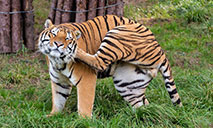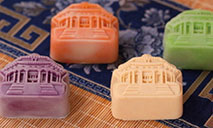China’s pet economy booms with shift towards high-end, subdivided consumption trends
The number of pet dogs and cats in urban China exceeded 100 million in 2020, an increase of 1.7 percent year on year, as indicated in a recent survey, pointing out that young people have become and are expected to remain the main driving force in this consumer market.

A visitor takes a photo for a cat during a pet expo held from April 9 to April 11 in Zhengzhou, central China's Henan Province, April 10, 2021. (Xinhua/Zhang Haoran)
According to a white paper on China's pet industry in 2020, among pet owners, the post-80s and post-90s generation account for 36.2 percent and 38.1 percent of the market, respectively. China's urban pet (dogs and cats) consumption market reached 206.5 billion yuan (about $31.98 billion) in 2020, an increase of 2 percent year on year.
The pet industry, encompassing sub-sectors ranging from pet breeding, pet food and pet-related consumer nondurable goods to veterinary medicine and pet-related funeral services, has come to cover all aspects of a pet’s life.
Statistics from Qichacha, a major enterprise credit investigation agency in China, showed that China is home to a total of 965,000 enterprises associated with pet products and 312,400 new enterprises in this category obtained their business licenses in the first half of 2021, an increase of 150.5 percent over the same period last year.
Xiaomi, who owns pet retail stores in south China’s Guangzhou and other cities, said it was "radical" when describing the new changes to pet owners’ consumer demand in recent years.
"A few years ago, when customers came to buy dog food, the first sentence they say was invariably ‘which one is the cheapest'. Now they often begin a conversation with ' which one is the best',” Xiaomi noted.
She further explained that in the past, owners had no awareness about styling their pets, and a dog’s hair was normally sheared off to as short as possible. In stark contrast, nowadays, when customers are informed that pet beauticians can be divided into the three grades of ABC, only the smallest segment of these customers would choose a service offered by C-level staff who, in any case, charges the lowest among the three choices.
The upgrading of consumer demand has further bolstered the continued subdivision of the pet industry.
Stella, who created the pet cat service brand Meow+ in 2019, also noticed this trend. "The younger generation of pet owners regard their pets as families and want to take care of their families as carefully as they do,” Stella noted.
Stella explained that “traditional pet shops run cat and dog businesses together, which resulted in a mixed market. And the practitioners are not professional enough. In fact, the two kinds of animals are quite different in terms of service demand and behaviors."
Stella’s pet business touches upon services ranging from purebred cat breeding, cat fur conditioning, housekeeping services for cat hotels, pet lifestyles and other services. Considering that cats are sensitive to their environment, flows of people, sounds and smells, and are particularly vulnerable to stress due to environmental changes, the cat-lover in the end decided to locate her store at a more secluded place within Beijing.
"From a commercial point of view, we hope for an overflow of customers when opening a new store. This is why traditional pet stores are often located at shopping malls or stores next to residential compounds. But since we are committed to the subdivision of professional cat business, we need to respect animal welfare, so everything is based on the needs of the cats themselves,” Stella further elaborated.
“Now some of our guests even come all the way from suburban Beijing, which reflects the fact that the service demand of younger-generation pet owners is changing, and there is still a lot of market potential to be tapped for this market segmentation," Stella said.
Photos
 Bumper harvest presents a magnificent scene of terraced rice paddies in SW China's Luzhou city
Bumper harvest presents a magnificent scene of terraced rice paddies in SW China's Luzhou city In pics: life of Siberian tigers in NE China's breeding center
In pics: life of Siberian tigers in NE China's breeding center Explore wonderland created by an alpine lake cluster in SW China's Yunnan
Explore wonderland created by an alpine lake cluster in SW China's Yunnan In pics: Museums across China unveil creative and culturally-inspired mooncakes
In pics: Museums across China unveil creative and culturally-inspired mooncakes
Related Stories
Copyright © 2021 People's Daily Online. All Rights Reserved.






